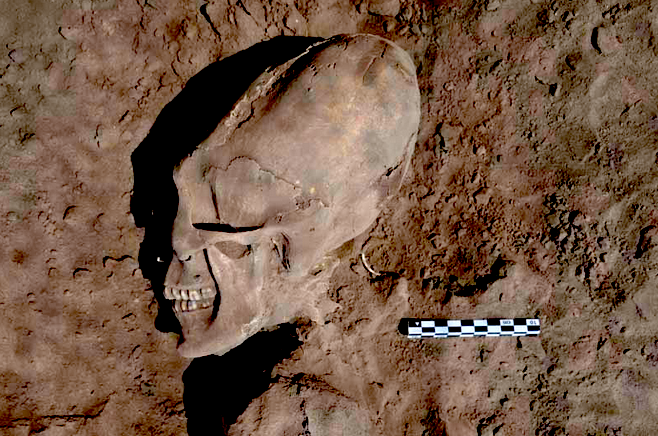Astonishing Alien-Like Skulls Discovered in Ancient Mexican Cemetery

Archeologists excavating an ancient, thousand-year-old pre-Hispanic cemetery near a small Mexican village of Onavas have uncovered a series of astonishing alien-like skulls of people who have suffered cranial deformation.
The discovery is believed to be the first in the region, and shows that the ancient Mesoamerican practice of skull binding was far more common than previously believed.
Artificial cranial deformation, also called head flattening or binding, is a practice of intentional body alteration in which the person's skull is intentionally deformed with applied force.
Researchers said that head binding in Mesoamerican cultures was likely done to signify one's group affiliation or as a way to show social status. The deformed heads may have also been seen as something that was aesthetically pleasing.
Archeologist Cristina Garcia Moreno and her research team from the Arizona State University and the National Institute of Anthropology and History discovered 13 of the 25 individuals in the ancient burial ground had skulls featuring cranial deformation and five also appeared to have dental mutilation.
"This unique find shows a mix of traditions from different groups of northern Mexico," Garcia Moreno said according to Past Horizons.
Like cranial deformation, researchers said that evidence of dental mutilation, another common practice in pre-Hispanic groups in southern Sinaloa and northern Nayarit believed to symbolize the rite of passage into adolescence, and the use of seashells as aesthetic ornaments have never been found in the Sonora region.
"The use of ornaments made from sea shells from the Gulf of California had never been found before in Sonoran territory and this discovery extends the limit of influence of Mesoamerican peoples farther north than has been previously recorded," she added.
Some of the skeleton remains belonged to people wearing ornaments like bangles, nose rings, earrings, pendants made from shells found in the Gulf of California. Researchers said that one burial contained a turtle shell that had been carefully placed over the abdomen, Past Horizons reported.
Garcia Moreno said that of the 25 skeletal remains, 17 were children between the ages of five months and 16 years old, and eight were adults. She said that in this specific case, all of the individuals buried may have belonged to the same social circle because the burials seemed to have the same characteristics.
However, researchers noted that they have not been able to determine why only one of the individuals buried was female and why only some of them were wearing ornaments.
Practice of head binding has been seen in many historical cultures, including Neanderthals. The earliest written evidence of cranial deformation dates to 400 BC in Hippocrates' description of the Macrocephali or Long-heads. The practice was usually carried out on infants because their soft skulls can be easily manipulated. To mold the skull, wooden boards were applied to the skull with pressure. Infants typically undergo this transformation between the age of about one month and then for the next six months.
However, like the latest find has revealed, the head binding was dangerous and extremely risky. Researchers found that the number of infants and children found in the cemetery may be an indicator of "poor practice," according to Past Horizons. Researchers said that the death of the young individuals was most likely caused by "excessive force while squeezing the skull," after analysis revealed that the individuals did not die of diseases.
After analyzing samples taken from one of the individuals, researchers date the latest find to the year of 943 CE.



























